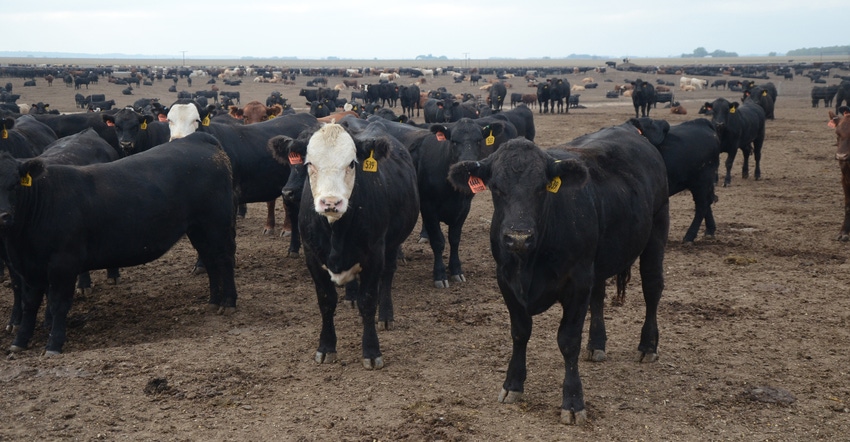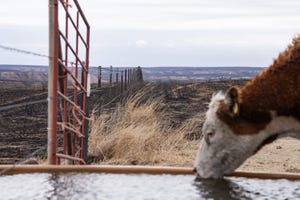Despite COVID-19, Iowa leads meat production
Livestock Outlook: The U.S. beef sector is bouncing back from pandemic disruptions, but soft beef prices had pressured earnings even before the feed cost surge.
May 21, 2021

The cattle industry — like probably everyone else — is more than happy to keep 2020 in the rearview mirror. But emerging data document the resiliency of beef production.
U.S. feedlots marketed 25.132 million fed cattle last year, down 754,000 head from 2019. Marketings from both 1- to 999-head feedlots and 1,000-head-or-more feedlots dipped roughly 3%. Just over 87% of the marketed cattle were produced in large feedlots, a ratio that has remained consistent over recent years.
As of Jan. 1, the one-time capacity of feedlots with capacity of more than 1,000 head was 17.200 million head, up 100,000 head from Jan. 1, 2020. Capacity is a flow indicator. Cattle go in and then go out. COVID-19-related disruptions slowed capacity use or turnover rate. Turnover can be calculated for 1,000-head-or-more capacity feedlots by dividing annual feedlot marketings by one-time capacity. Longer feeding times in 2020 slowed turnover rates. Even though this metric fell from 2019 and 2018 levels, it was still higher than in the six prior years.
Persistently negative returns are often a sign of overcapacity. That currently is not the case. Some capacity cushion exists that allows cattle to stay in lots if downstream disruptions occur. That proved advantageous during COVID-19 disruptions. But no excess capacity that needs to be painfully wrung out of the system exists.
Last year, 42% of the fed cattle marketed in Iowa came from feedlots with a capacity of 1 to 999 head, down 2 percentage points from 2019. Iowa marketings dipped 159,000 head, or 8.5%, from 2019. The majority of the decline was from farmer-feeders. Feedlots with a capacity of 1 to 999 head marketed 98,000 head, or 12.0% less. Marketings from Iowa feedlots with a capacity of 1,000 head or more slipped 61,000 head, or 5.7%.
Despite COVID-19, beef keeps moving
The USDA National Agricultural Statistics Service published the Livestock Slaughter 2020 Summary in April. Data come from reports completed by the Food Safety and Inspection Service; and USDA, combined with data from state-administered, non-federally inspected slaughter plants. Commercial beef production totaled 27.173 billion pounds in 2020, actually up 0.1% from 2019. Production averaged 533 million pounds per week – an amazing number if you think about it!
Even during April and May 2020, roughly 415 million pounds per week of a wide range of beef products moved through the pipeline, mostly through retail groceries. COVID-19 restricted movement through restaurant, food service and export markets each week. Still, beef had to keep moving, because cold storage space is limited and demand was strong.
Iowa leads meat production
Iowa accounted for 16.1% (8.96 billion pounds) of 2020 U.S. commercial red meat production, up from 15.7% (8.624 billion pounds) in 2019. Not enough detail is available to say how much of Iowa's red meat production is beef, veal, pork, and lamb and mutton. These statistics also indicate where slaughter occurs, not necessarily where farm production happens. A large share of Iowa cattle are slaughtered in either Nebraska or east of the Mississippi River.
Still, Iowa has led the nation in commercial red meat production the last two years. Prior to that, Nebraska had that distinction for 23 consecutive years, 1996-2018. From 1977 to 1995 Iowa held the title – except in 1986, when Kansas had the top spot.
USDA released the Meat Animals Production, Disposition and Income Annual Summary at the end of April. The USDA report provides the annual balance sheet and income estimates for cattle and hogs by state and nationally. U.S. production of cattle and calves totaled 45.458 billion pounds in 2020, up 1.9% from 2019. Total 2020 production of cattle and calves, and hogs and pigs, in Iowa totaled 15.126 billion pounds, down 8.9% from 2019. Production rose 0.8% for cattle and calves, but dipped 10.3% for hogs and pigs. Cattle and calves accounted for 14.1% of the combined production of cattle and calves and hogs and pigs in Iowa, up from 12.7% in 2019.
Small packing plants grow
The U.S. had 683 federally inspected (FI) cattle slaughter plants in 2020, compared with 670 in 2019. This is the largest number of FI cattle slaughter plants since 2004. Of these, 446 plants slaughtered between 1 and 999 head of cattle during 2020, down 34 plants from 2019. These plants didn't go away. Many smaller plants scaled up production.
In 2020, there were 152 FI plants that slaughtered between 1,000 and 9,999 head of cattle, compared to 107 plants in 2019. Using simple category averages, this equates to plants going from slaughtering roughly 7 head per week to 44 head per week, based on slaughtering 52 weeks per year. Plants slaughtering between 1 and 9,999 head still only processed 1.6% of the total FI cattle kill.
The 13 largest plants, each slaughtering more than 1 million head per year, slaughtered 53.9% of all FI cattle. While up 1.5 percentage points from 2019, these large plants had the smallest share of slaughter since 2005.
The number of FI cattle plants and the number of head slaughtered is not reported for Iowa to avoid disclosing data for individual operations. Iowa has 23 FI packing plants slaughtering cattle and calves, hogs, sheep and lambs, goats or bison. Iowa has 93 other or non-FI livestock slaughter plants. These could be plants which sell and transport only intrastate, where state inspectors assure compliance with individual state standards. Or they could be plants that do not sell meat but operate on a custom basis only.
Iowa has 3% of the FI slaughter plants nationally, and 5% of the other slaughter plants. Pennsylvania has the most FI livestock slaughter plants with 84, and Texas is second with 42. Nothing is known about size, though. Texas and Montana are tied for the most other livestock slaughter plants, with 164.
Good volume, lower prices
Nationally, cash receipts from marketings of cattle and calves slipped 4.8%, from $66.267 billion in 2019 to $63.089 billion in 2020. Lower prices, not less production, was the culprit. The 2020 figure is 22.2% smaller than 2014's record $81.077 billion. This marks the lowest level of cattle industry cash receipts since 2011.
In Iowa, 2020 cattle and calf cash receipts slid 6.0% to $3.786 billion. The value of Iowa cattle and calf production dipped 9.1%. Value of production removes the value of sales between producers (predominantly calves and feeder cattle), leaving just net value added by cattle producers. Iowa is a net importer of feeder cattle. In 2020, Iowa shipped in 110,000 fewer cattle, or 7.0% less, than in 2019. Iowa cattle marketings fell 55,000 head, or 2.2%, though calf marketings were unchanged.
Iowa dropped a spot and now ranks fifth for cattle and calf cash receipts ($3.786 billion). It remained the No. 5 state for value of production ($2.347 billion). Nebraska ($9.645 billion), Texas ($8.510 billion), Kansas ($8.320 billion) and Colorado ($3.820) took the top four spots for total cash receipts. Texas remained the No. 1 state for value of cattle and calf production ($7.245 billion) due to its larger cow-calf sector.
Feedlots make up a larger portion of Nebraska's cattle industry. The value of feeder cattle that feedlots buy is deducted from total cash receipts to compute the value of actual production in Nebraska. The same can be said for Oklahoma over Iowa, with respect to value of production.
Schulz is an Iowa State University Extension livestock economist.
About the Author(s)
You May Also Like



.png?width=300&auto=webp&quality=80&disable=upscale)

